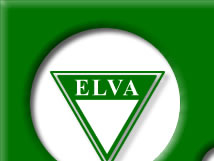|
Following on from his success in the C.S.M., Frank Nichols told Charlie
Toghill to roof over the yard area at the London Road Garage to give extra
workshop space as the second workshop behind the York Hotel was being
fully utilised. It was not long before Charlie was asked to spend less
time in the second-hand car business as they were all going to concentrate
on building chassis and maybe even complete a car.
Nichols thought he should try to build at least two finished cars to
be entered at the start of the 1955 season,. Early in 1955 the first Elva
rolling chassis powered by the I.O.E converted Ford engine was taken to
Brands Hatch for further testing and subsequently the Murphy brothers
helped Frank to shape thin tubing to form hoops and establish a body shape
for the prototype car. This aluminium body was functional rather than
attractive, but it was the first attempt and rather better things were
to come!
This first car was built at the rear of the York Hotel in London Road,
Bexhill during January and February 1955 by Keith Marsden and ‘Mac’ Witts,
the chassis frame having been welded by master welder Arthur Lee. Frank
was confident that his new aluminium bodied prototype Elva would easily
out accelerate the C.S.M. and exceed the maximum top speed by at least
10mph. The engine was still the Ford Ten unit but had received a modification
which would become crucial to the future good fortunes of Elva Engineering.
Following suggestions made by Frank, ‘Mac’ Witts had been instrumental
in changing the chassis layout from that of the C.S.M., and he also designed
a modification to give the engine overhead inlet valves. The first prototype
head had been tried briefly on the C.S.M. and this was developed into
the ‘L.R.G.’ I.O.E. conversion which was supplied as a kit suitable for
use on the Ford Ten (E93A) engine thus replacing the existing cylinder
head on all the Ford Eight and Ten models manufactured between 1938 and 1953.
‘Mac’ had worked hard developing the idea, securing the help and the
much respected gas-flow expertise of Harry Weslake of Weslake & Co., who
were at nearby Rye. Harry Weslake is well known for his work on gas-flow,
combustion chambers and port designs on many famous engines including
those used by Jaguar.
‘Mac’ initially made some rather crude wooden pattern for Birmingham
Aluminium to produce some castings, and when the very first sample casting
was delivered to the London Road Garage, ‘Mac’ set about sawing it in
half to check the water passages, nearly causing Frank to have a fit as
he had already sold it to a customer!
Initially some rather basic methods were employed to produce the heads,
but the demand for the conversion soon became apparent and a simple production
run was established. Early machine work was carried out locally by Coville
& Ford who were in Hurst Green, although at a later date Bob Townsend
had the job of cleaning up the castings and making all the other small
parts to complete the kit.
|
The LRG head was very successful in terms of increased performance
and improved fuel economy, and was to become a reliable and regular
source of income for the Elva Engineering Company for some time.
It became available
with either 8:1, 9:1 or 10:1 compression ratios, used 1 3/8” inlet
valves and was supplied as a kit complete and ready to fit. The
existing inlet valves were transferred to the new head, while the
old exhaust valves were retained in the original position.
The kit consisting
of the head, push rods, rockers etc. and was originally sold for
£65.00 with the result being a very respectable 60% increase in
the power output from the Ford Ten power unit.
|
|
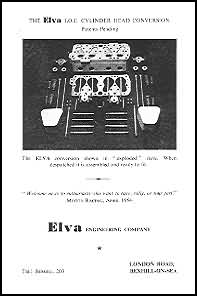 |
Soon it was announced that the ‘ELVA’ chassis was in production with a
delivery date of 4 6 weeks. The price of the bare chassis frame, including
engine mounts, trailing links, pedals, rear suspension units and stressed
aluminium under tray (floor) was £120.00 The preferred option was to supply
components to make up a rolling chassis complete, which was easily assembled
in little over one hour, with the complete kit to produce the rolling
chassis with engine mounts to suite at £350.00 Chassis frames were being
built and offered for sale alongside the engine conversion, and meanwhile
the prototype Elva was being noticed on the track.
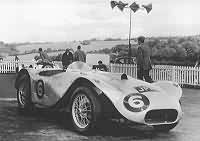 |
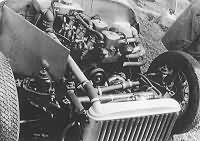 |
Prototype
Elva at Brands Hatch,
and an under bonnet view showing
the IOE conversion and four Amal carburettors |
An ever confident Frank now wanted to produce a dozen cars in component
form before the end of 1955, and he was on target. He did however have
one unpleasant brush with HM Customs over a misunderstanding regarding
the Purchase Tax rulings, as he was keen to keep prices to the minimum
and did not include any tax within the selling price as completed cars
were not officially being sold. There was obviously some confusion, as
he was sent a rather large bill for tax apparently due, and he was eventually
summoned and was forced to seek the advice of a barrister.
He was told that the situation did not look good, but undeterred he strode
up to the desk of the Customs officer thrusting an official looking document
at him and accused the officer of gross harassment. Luckily, the document
was not read as it gave Frank little chance of winning the case, but nothing
more was heard. However, Frank was known to have hidden in a stationary
cupboard on more than one occasion during further visits from HM Customs
& Excise!
The prototype car was entered at Goodwood on the 26th March 1955 for
several races showing the Trade Plate registration ‘658 AP’. Unfortunately
it did not start the race with Sussex based Betty Haig at the wheel, but
after some hasty work it was driven by D. J. Wakeling although he managed
to spin twice on the first lap.
Next to try the car was Peter Gammon and he achieved a 2nd place in the
1200cc race despite a blown head gasket. He had shot into the lead from
the grid and had held this position until the fourth lap when the gasket
blew and he finished on two cylinders.
Frank was naturally delighted and offered Peter the chance to drive the
car again on Easter Meeting at Brands Hatch on 11th April where he roared
home to a 1st place in the 1200cc race, in front of the Lotus drivers
Richards and Hicks, and finishing 3rd in the 1500cc race. Peter finished
5th in the unlimited race after a spin and was referred to as something
of a giant killer with reports of the ‘incredible Gammon - Elva combination’.
Certainly the Elva was the star a few weeks later when Peter achieved
a 3rd place at Brands on the 1st May in the 1200cc race - things were
looking good for Frank Nichols and Elva and were to get even better with
another enthusiastic and accomplished young driver already waiting in
the wings.
Frank had expressed his desire to find a driver, local if possible, who
had some sports car racing experience and some capital. It was during
a general practice day at Brands Hatch that Frank spoke to Robbie Mackenzie-Low
and offered him a few laps in the prototype now registered as ‘JPN 875’.
Born in May 1931, Robbie was coincidentally living in Bexhill at the time
although his grandparents had been involved in the Scottish Jute industry,
and his father was widely known in the Philatelic business.
His motorsport activities began in 1952 with rallies and circuit racing
in Jowett Javelins and a Jupiter supplied by Cooden Engineering. Robbie
raced the Jupiter at the BARC Goodwood Members Meeting in 1953, and then
a F3 Cooper Mk.VII and Cooper-Bristol following a very special day at
the circuit under the instruction and watchful eye of S.C.H. ‘Sammy’ Davis.
Robbie had started the ‘55 season in a Mk.IX Formula 3 Cooper, and at
the Brands Hatch Easter Meeting came second to Jim Russell having been
‘robbed’ of a win with a failing clutch on the second to last lap.
Having timed Robbie in the Elva, an impressed Frank asked him to call
in to the garage where an Agreement was signed for Robbie to drive the
Elva in National and International 1100cc and 1500cc sports racing events
for the rest of the 1955 season.
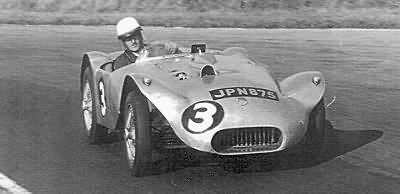 |
Robbie
Mackenzie-Low at Brands Hatch
Sunday 9th October 1955 |
His first race was at the new Aintree circuit on the 21st May, where
the Elva team must have been delighted with a 1st in the 1250cc race winning
by at least half a mile being unchallenged throughout, and with fastest
lap, and this was followed by a 2nd place in the 1500cc race.
The next day Robbie and Keith drove to the Prescott hill for the Bugatti
Owners Club National Hiliclimb where Robbie again achieved a 1st and a
class record, with Les Leston driving the same car into 2nd place. Les
Leston had first tried the car and beat the class record with 52.25 secs,
but then Robbie knocked over a second off the time, with 51.14 secs, which
was a new record and better than that of the 1500cc cars. This was Robbie’s
very first hillclimb and Frank was over the moon.
The enthusiastic team at Elva Engineering were learning fast and there
were to be many more successes but also some difficult times to come.
|




